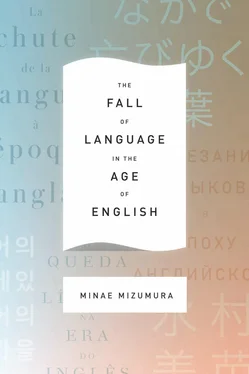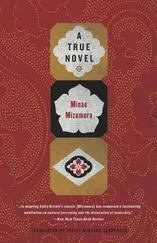Let us go back to ancient Japan, as it became part of the Sinosphere. What reached the archipelago were bundles of precious scrolls with writing on them, scrolls that the Japanese learned to read from Korean settlers. To be sure, there were only a handful of Japanese bilinguals in the beginning, but their presence enabled Japan to join the Sinosphere alongside Korea and Vietnam. The Japanese thus gained entry into the library of Chinese texts, the library of an “external language”—the universal language of the region. And by gaining entry into this library, they also entered a society in which there was a linguistic double structure of “universal/local language,” just as in the pre-Gutenberg societies of Europe — or indeed as in many premodern societies.
Like the Bible in Latin or the Qur’an in Arabic, which spread far and wide as sacred texts, what first reached Japan were Buddhist scriptures in Chinese, which, significantly enough, were themselves translations from Sanskrit. Initially, facing these beautiful calligraphic scrolls, Japanese people probably never dared imagine that they were anything other than texts to be deciphered with veneration—“texts to be read.” The idea that the same characters used in them might be used to represent their own language — the language they chattered in the streets — would have seemed preposterous, all the more so because Chinese characters are ideograms and not phonograms; that is, they represent meaning and not sound. (More precisely, most Chinese characters are phono-semantic compounds, having a dual function, but I will use the term “ideogram” to simplify my argument.) Nonetheless, the general rule that a local language acquires a written language by translation of a universal language applies to Japanese as well. For it was through translation that the Japanese people started to use these characters to express their own language.
The process was a tortuous one that took centuries, not only because Chinese characters are ideograms, but because the Chinese and Japanese languages are totally unrelated. In fact, it seems almost surreal that two languages could be so far apart, given the geographic proximity of the two countries. Word order is opposite. Chinese follows the same subject-verb-object order as English, but this is reversed in Japanese; “I love you” becomes “I you love.” Moreover, Chinese, especially Classical Chinese, is what is called an “isolating language,” while Japanese is an “agglutinative language”: in Chinese, each semantic unit is directly followed by another; in Japanese each semantic unit must be followed by a particle or suffix — a little bit of “glue”—that connects it to the next. So, in the example, in Japanese two particles must be inserted to mark the subject and object: “I ( wa ) you ( wo ) love.” What is most astonishing and instructive to us who are the products of modernity is that, even faced with such a seemingly insurmountable linguistic barrier, Japanese people never thought of just going ahead and inventing their own letters or their own writing system to better represent the language they spoke — that it was as a by-product of the act of translation that they eventually acquired their own method of writing.
The Japanese who first learned to read Chinese from Korean settlers in the fifth or sixth century must have read it in the original word order, though this is impossible to establish. What we do know is that sometime during the Nara period (710–784), people were already reading Chinese as if it were Japanese, inverting the word order and adding small inversion marks to the text to indicate where and how the inversions should take place — a method still used today to read the Chinese Classics. This practice, called “Chinese writing, Japanese reading” ( kanbun kundoku ), was a primordial form of translation. (The Korean language has word order similar to that of Japanese, and Koreans may have already been doing something similar.) The next step was to add, in small lettering alongside the inversion marks, the particles and suffixes necessary to read the text as Japanese. Of course, at this point, the Japanese still had no distinctive letters of their own to represent the sounds of their language. They compensated by taking the meanings away from certain Chinese ideograms and using them simply for their sound value, as phonograms. Using this method of writing, they gradually succeeded in amassing a vast collection of indigenous poetry that is still read and loved today: Ten Thousand Leaves . Visually, the poems appear to be Chinese, but phonetically and semantically they are Japanese. Chinese characters used this way are called man’yōgana (letters of Ten Thousand Leaves ).
The following Heian period, when Lady Murasaki Shikibu wrote the masterful Tale of Genji , represents the true birth of vernacular writing. Since the seventh century, the Japanese government had been sending missions regularly to China to learn from the higher culture, but the practice came to a halt at the beginning of the Heian period for various reasons, the collapse of the mighty Tang dynasty being one. (The final mission was canceled in 894.) Chinese influence remained strong, but without any direct and centralized contact with China, indigenous culture began to flourish. More self-confident, Japanese people turned their method of translation into something more elaborate.
Besides the little inversion marks, particles, and suffixes, people began to write full translations alongside the text, still using Chinese characters as phonograms. These additions — interlinear texts of a sort — first appeared in minuscule writing, as if they knew they didn’t belong. Gradually, the characters used for this purpose were simplified, requiring fewer brush strokes and slowly evolving into distinctive letters in their own right. In the process, they split into two systems of phonograms or “syllabaries,” as they are known, each letter representing a syllable of Japanese. Thus were born today’s katakana and hiragana, the indigenous products of translation.
To give you an idea of what these syllabaries look like, here is the word “katakana”—which originally meant “partial characters”—written in katakana: カタカナ. It is composed of straight lines, exuding masculinity. And here is the word “hiragana”—which originally meant “easy characters”—written in hiragana: ひらがな. As you see, unlike katakana, hiragana is composed of curved lines, exuding femininity. The word “kana” is used when referring to both syllabaries. Chinese characters, meanwhile, were called magana or “real characters,” written 眞仮名. The difference between kana and magana is visually obvious.
Why two sets of kana? True, the language could perhaps have done just as well with one. It ended up with two because of the split created by the very binary between the universal language and the local language. Katakana continued to be used when translating the universal language and long remained subordinate to it. As Japanese people became more comfortable writing in their own language, interlinear texts using the two syllabaries grew larger and bolder, but because of katakana’s close relation to the universal, its process of enlargement took much longer than its counterpart.
Hiragana became distanced from Chinese early on as it was quickly relegated to the role of writing the local language. First it became the medium of choice for writing indigenous waka poetry — poetry in syllabic groupings of 5-7-5-7-7 that was a precursor to haiku. Then it was used in headnotes, prose descriptions of the situations in which those short poems were composed, like this one from the first imperial anthology of waka poetry, compiled in 905: “On hearing the call of a wild goose and thinking of a friend who had gone to Koshi.” 3These descriptions grew longer — often longer than the poems they introduced — and eventually evolved into short fictional narratives centering on poems. And who should be the greatest users of hiragana but well-educated ladies, for whom it was socially unacceptable to write in Chinese? (The exclusion of women from learning the universal language is the norm in any society where there is a binary between the universal and the local.) Ladies began writing prolifically in various prose genres — fiction, essays, literary diaries — using hiragana. The association with women’s writing became so close that hiragana was often referred to as “women’s hand” ( onnade ) in those early years. Such writing in hiragana also became known as yamato kotoba , literally “Japanese words,” to distinguish it from writing in Chinese. The Tale of Genji , a work of astounding psychological subtlety, is the greatest exemplar of yamato kotoba .
Читать дальше












